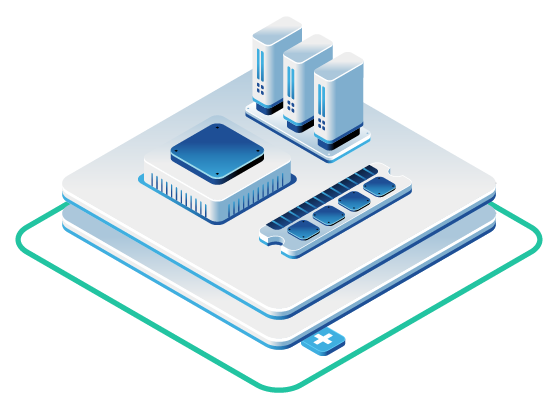In this article
- Balancing Big Data Ambition with Control
- Decoding the Language of Data Control: Sovereignty vs. Governance
- Why Public Clouds Complicate Big Data Sovereignty and Governance
- How a Hosted Private Cloud Provides a Sovereign Foundation
- Blueprint for a Secure and Governed Big Data Architecture on OpenMetal
- Analyzing the Total Cost of Ownership for Big Data Infrastructure
- Wrapping Up: Big Data Sovereignty and Governance Using Hosted Private Cloud
- Ready to Build Your Big Data Pipelines on OpenMetal Cloud?
When you’re using massive datasets to make business decisions, the infrastructure behind your big data operations gets put under a microscope. You’re probably caught between two competing needs: the demand for scalable, high-performance computing to crunch huge amounts of data, and the absolute necessity of keeping control over it. This is especially tricky because of what big data is, often defined by the “Five Vs”: high Volume, high Velocity, a wide Variety of data types, and the need to ensure its Veracity (accuracy) to derive real Value.
Picking an infrastructure like a public cloud can make data sovereignty and governance really complicated, especially when you’re working with sensitive information that falls under rules like GDPR or HIPAA. This article will show you how a hosted private cloud, specifically OpenMetal’s on-demand private cloud, solves this problem. It gives you the control and performance you need for tough big data jobs like Apache Spark and Hadoop, while also setting up a solid base for data sovereignty and governance.
Balancing Big Data Ambition with Control
The push for big data and artificial intelligence (AI) projects is making many teams rethink how they manage their data. Tools like Apache Spark and Hadoop are built to spread out processing jobs across many machines, which makes them seem perfect for the cloud and its promise of easy scaling.
But as you move these sensitive workloads to the cloud, you run into a new set of problems. The convenience of public cloud platforms can mean giving up control, which clashes with the strict needs of data sovereignty and governance. You have to be able to answer some basic questions: Where is your data physically located? Which country’s laws apply to it? Who can access it? How do you prove to auditors that you’re compliant? In a shared public cloud, getting straight answers to these questions can be tough, or even impossible.
Decoding the Language of Data Control: Sovereignty vs. Governance
To build a big data setup that follows the rules, you need to be clear on a few key terms. People often throw around words like data sovereignty, governance, residency, and localization as if they mean the same thing, but they don’t. Each has its own technical and legal meaning.
What is Data Sovereignty?
Data sovereignty is the idea that your data is subject to the laws of the country or region where it was collected. For instance, if you collect data from customers in the European Union, that data falls under the EU’s General Data Protection Regulation (GDPR), no matter where your company is based or where you physically store the data. This concept is all about who has legal authority over the data.
Two other related terms are:
- Data Residency, which is the physical, geographic location where you decide to store your data. Picking a data center in a specific country is a data residency decision.
- Data Localization, which is a law that says data collected in a country must be stored inside that country’s borders. This is a strict, legally required form of data residency.
What is Data Governance?
If data sovereignty is about the external laws you have to follow, data governance is the internal rulebook you create to make sure you can follow them. Data governance is all about managing your data to keep it high-quality, available, and secure by using a clear set of policies, standards, and procedures.
A solid data governance framework is a must-have for big data. It creates clear ownership and control by:
- Defining Roles and Duties: It names data owners (who are responsible for certain types of data) and data stewards (who manage the data day-to-day).
- Setting Data Standards and Policies: It creates rules for data formats, metadata, access controls, and how data is managed over its entire life—from when it’s collected to when it’s archived or deleted.
- Establishing Auditing Procedures: It lays out how you’ll test and keep records to prove you’re following both your own policies and outside regulations.
You can’t have data sovereignty without good governance. Sovereignty tells you what laws apply to your data, while governance gives you the internal setup to identify that data, control where it is and who can access it, and prove to regulators that you’re playing by the rules.
| Term | Definition | Primary Focus | Example |
|---|---|---|---|
| Data Sovereignty | The concept that data is subject to the laws of the country where it was generated or its owner resides. | Legal Jurisdiction | Data collected from German citizens is subject to Germany’s laws (and the EU’s GDPR), regardless of where it is stored. |
Data Governance | The internal framework of policies, roles, and procedures for managing data assets to ensure quality, security, and compliance. | Internal Control & Policy | An organization defines a policy that only specific roles can access customer PII and implements an auditing system to track all access. |
| Data Residency | The physical, geographic location where an organization stores its data. | Physical Location | A Canadian company chooses to store its customer data in a data center located in Toronto. |
Data Localization | A legal requirement that data generated within a country must be physically stored within that country’s borders. | Mandated Physical Location | A national law requires all healthcare data of its citizens to be stored on servers located within the country. |
Why Public Clouds Complicate Big Data Sovereignty and Governance
Public clouds are great for scaling up, but their shared-everything model creates some major headaches for data sovereignty and governance. The same features that are supposed to make them reliable and fast can actually put you at risk of breaking compliance rules.
The main problem is a loss of control and transparency. When you use a public cloud, your data is handled according to the provider’s rules, which are often a black box. This leads to several specific issues:
- Automated Data Replication Across Regions: To be resilient, public cloud providers copy your data automatically. This can lead to copies of your data being stored in places and under laws you never agreed to, and you might not even know it’s happening. This could easily violate data localization laws.
- Ambiguous Disaster Recovery Jurisdictions: Failover systems are built to move your data to a healthy region if there’s an outage. While this is great for keeping your business running, it can expose your data to foreign laws, even if it’s just for a short time.
- Conflicting Legal Frameworks: If you store data with a U.S.-based hyperscaler, even in an EU data center, it could be subject to the U.S. CLOUD Act. This can directly conflict with privacy rules like GDPR, which limit data transfers outside the EU.
- Lack of Transparency and Auditability: Because the underlying hardware is a shared black box, it’s hard to check for yourself or prove to an auditor that your data hasn’t crossed into another jurisdiction at some point, whether it’s in transit, at rest, or in a backup.
This points to a big gap in the public cloud’s “shared responsibility model.” The provider is responsible for the security of the cloud, but you’re responsible for security and compliance in the cloud. The problem is, you can’t be fully responsible for your data’s sovereignty if you can’t see or control what the provider is doing at the infrastructure level.
How a Hosted Private Cloud Provides a Sovereign Foundation
An OpenMetal Hosted Private Cloud gets rid of the gray areas you find in public cloud setups. It gives you full control over your own private, isolated environment, which is exactly the foundation you need for secure and sovereign big data solutions. It’s a direct answer to the problems of shared infrastructure.
Full Control Over Dedicated Hardware: Your Geographic Anchor
OpenMetal gives you an on-demand private cloud built on hardware that’s all yours. Your cloud core is physically located in a data center you know, and its resources aren’t shared with anyone else. This single-tenant model is the key to data sovereignty. You have a clear, provable answer to the question, “Where is my data?” This gets rid of the risks that come with hidden data replication and disaster recovery in public clouds, giving you a fixed geographic and legal home for your data.
Bare Metal Performance for Uncompromised Big Data Processing
For big data jobs like Apache Spark and Hadoop, you can’t afford to sacrifice performance. OpenMetal gives you full root-level access to your cloud core’s dedicated hardware. That means no shared resources, no “noisy neighbors” hogging your CPU or I/O, and no “hypervisor tax” slowing things down. You get true bare metal performance, so your data pipelines run smoothly and predictably. This lets you put all the necessary security and governance controls in place without hurting the performance of your analytics.
Open Source and API-Driven: Build Your Stack Without Vendor Lock-In
The OpenMetal platform is built on OpenStack, a top open source cloud operating system. This gives you the freedom to build and customize your big data stack with any tools you want. You’re not stuck with one vendor’s proprietary analytics or governance tools. This control over your entire software stack is a kind of technical sovereignty. It lets you pick the best tools for your specific compliance and security needs and connect them all through open APIs.
| Public Cloud | OpenMetal Hosted Private Cloud |
|---|---|---|
Hardware Tenancy | Multi-Tenant (Shared) | Single-Tenant (Dedicated) |
| Physical Location Control | Abstracted; replication can cross jurisdictions | Explicit; hardware is in a known, fixed location |
Root-Level Access | No; access is to a virtualized slice | Yes; full root access to the cloud core hardware |
Network Isolation | Logical separation via VPCs | Physical and logical isolation |
Performance Consistency | Variable; subject to “noisy neighbors” | Consistent and predictable bare metal performance |
Software Stack Flexibility | Limited to provider’s ecosystem and APIs | Complete; use any open-source or commercial software |
| Auditability | Limited to provider-supplied logs and tools | Full; complete access to all system and hardware logs |
Blueprint for a Secure and Governed Big Data Architecture on OpenMetal
Once you have the solid foundation of an OpenMetal cloud, you can use the tools already in OpenStack to build a secure, multi-layered setup for your big data jobs. This blueprint will walk you through using core OpenStack services to put your data governance policies into action.
Step 1: Isolate Workloads with OpenStack Neutron Security Groups
Your first line of defense is network isolation. OpenStack Neutron, the networking service, lets you create virtual networks to separate your infrastructure. Security Groups work like stateful virtual firewalls, controlling traffic coming in and out of each instance at the port level.
You can apply the principle of least privilege by creating specific security groups for different parts of your big data pipeline. For example:
- A
data-ingest-sgthat only allows traffic from your trusted data sources. - A
spark-master-sgthat allows admin access and communication from worker nodes. - A
spark-worker-sgthat only allows traffic from the master and access to your data storage.
You can create these rules from the OpenStack command line.
# Create a security group for Spark worker nodes
openstack security group create spark-worker-sg --description "Rules for Spark worker nodes"
# Allow all TCP traffic from the Spark master security group
openstack security group rule create spark-worker-sg \
--protocol tcp --dst-port 1:65535 \
--remote-group spark-master-sg
# Allow SSH access only from a specific management network
openstack security group rule create spark-worker-sg \
--protocol tcp --dst-port 22:22 \
--remote-ip 192.168.100.0/24Step 2: Enforce Access Policies with OpenStack Keystone RBAC
The next layer is managing who can access what. OpenStack Keystone is the service that handles users, projects, and roles. Keystone’s Role-Based Access Control (RBAC) is how you enforce your data governance policies.
Instead of giving permissions to individual users, you can create roles—like data_analyst, data_engineer, or compliance_auditor—and give them specific permissions to use OpenStack resources and APIs. This makes sure that users and applications only have the access they absolutely need to do their jobs, which lines up perfectly with the roles and responsibilities in a formal data governance plan.
Step 3: Secure Data Access for Analytics Workloads
The final layer connects your infrastructure controls to your big data apps. It’s not enough to just secure the servers; you also have to make sure the analytics jobs themselves follow your access rules.
When you use Apache Spark to process data stored in OpenStack Swift (the object storage service), you can set up Spark to authenticate with Keystone. By using the hadoop-openstack library, Spark jobs will need a valid Keystone token to get to the data. This ensures that the same RBAC policies that control the infrastructure also control the application.
You set this up in your Hadoop core-site.xml file, which Spark uses for its Hadoop integrations.
Configuration Example: Securing Spark Access to OpenStack Swift with Keystone
<configuration>
<property>
<name>fs.swift.service.keystone.auth.url</name>
<value>http://YOUR_KEYSTONE_IP:5000/v3/auth/tokens</value>
</property>
<property>
<name>fs.swift.service.keystone.tenant</name>
<value>your_big_data_project</value>
</property>
<property>
<name>fs.swift.service.keystone.username</name>
<value>spark_service_user</value>
</property>
<property>
<name>fs.swift.service.keystone.password</name>
<value>your_secure_password</value>
</property>
<property>
<name>fs.swift.service.keystone.domain.name</name>
<value>Default</value>
</property>
<property>
<name>fs.swift.service.keystone.public</name>
<value>true</value>
</property>
</configuration>
Note: Storing credentials directly in configuration files is not recommended for production. Use a secrets management tool like OpenStack Barbican or HashiCorp Vault.
This layered approach gives you a defense-in-depth security model. Neutron isolates services at the network level, Keystone controls API access, and application-level authentication makes sure data access is governed by your central identity policies. And because every part is open source, the entire chain of command is transparent and easy to audit.
Analyzing the Total Cost of Ownership for Big Data Infrastructure
If you’re a technical decision-maker, you know that performance and security are top priorities. But the total cost of ownership (TCO) is just as important. When big data jobs run around the clock, they often hit a “tipping point“. That’s when the public cloud’s pay-as-you-go pricing gets a lot more expensive than a private cloud with a predictable bill.
The unpredictable nature of public cloud bills is usually caused by two things for big data:
- Data Egress Fees: Public cloud providers hit you with big fees, usually between $0.08 and $0.12 per gigabyte, just to move data out of their network. If you’re constantly moving terabytes of data for analytics, backups, or sharing, these fees can add tens of thousands of dollars to your monthly bill and lock you in.
- Wasted Resources: To avoid performance problems from “noisy neighbors,” teams often overprovision their virtual machines, which means they’re paying for capacity they’re not even using. One study found that, on average, only 13% of provisioned CPUs and 20% of allocated memory in some cloud-based Kubernetes clusters are actually used. That’s a lot of wasted money.
OpenMetal’s hosted private cloud model solves these problems with a fixed monthly cost for your dedicated hardware and a fair bandwidth pricing model. Since the hardware is all yours, you can push utilization way higher without performance issues, which lowers your cost per workload. For big, predictable jobs, this leads to a much lower TCO.
| Term for ~593 VMs | AWS EC2 (c5ad.large equivalent) | OpenMetal XL v2 | Savings |
|---|---|---|---|
| Monthly On-Demand | $45,769.19 | $6,105.60 | 86.6% |
| 1-Year Reserved | $367,416.48 | $64,475.16 | 82.5% |
| 3-Year Reserved | $806,152.32 | $156,059.28 | 80.6% |
Source: OpenMetal TCO Analysis, including 36TB of egress for comparison
Wrapping Up: Big Data Sovereignty and Governance Using Hosted Private Cloud
If you’re managing large-scale data, you can’t let innovation come at the cost of control. Public clouds are an easy way to get started, but they create major architectural and financial problems when you’re trying to manage data sovereignty and governance at scale. The lack of transparency, the risk of your data ending up in another country, and surprise bills create serious risks for your business and your compliance status.
A hosted private cloud from OpenMetal is a clear alternative. By giving you dedicated, single-tenant hardware in a location you know, you get the geographic and legal certainty you need for data sovereignty. With full root-level access and a foundation in open source OpenStack, you have the control and flexibility to build a secure, compliant, and high-performance big data stack. For companies where data is the most valuable asset, taking full ownership of your infrastructure is the smart choice.
If you’re ready to move beyond the limitations of public cloud and build a big data platform that meets your requirements for performance, security, and governance, our team is here to help. With deep expertise in deploying and managing large open source big data pipelines, we can help you design and validate your architecture.
Contact us today to discuss your project, or schedule a consultation with one of our cloud experts.
Interested in OpenMetal Cloud?
Schedule a Consultation
Get a deeper assessment and discuss your unique requirements.
Read More on the OpenMetal Blog


































